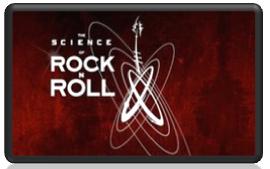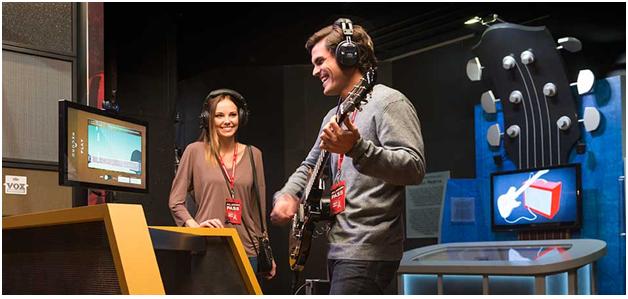Just when you thought that between the Hard Rock Cafe, the Rock and Roll Hall of Fame, and Scott Segelbaum’s “Rock Art Shows” that the genre has been brand extended for every conceivable exhibit, something new – and exciting – comes along.
 You may know Alan Cross, a self-described “professional music geek” from Canada, who always has a fascinating point of view about just about everything related to music. His blog, “A Journal of Musical Things,” is always fun and thought-provoking.
You may know Alan Cross, a self-described “professional music geek” from Canada, who always has a fascinating point of view about just about everything related to music. His blog, “A Journal of Musical Things,” is always fun and thought-provoking.
Over the holiday weekend, Alan sent me a note about his newest project, “The Science of Rock ‘n’ Roll,” a brand new exhibit that is now open in Kansas City at Union Station through May 2013. It looks amazing and showcases the mash-up of rock music and science, from how your brain processes music to the history and impact of the electric guitar. There are some very cool interactive displays as well.
Alan is the exhibit’s content director and took a few minutes to give me some of the highlights of “The Science of Rock ‘n’ Roll.”
FJ: Alan, how did the concept come about?
AC: A couple of guys who had worked together in the past (one of whom was well-known in the touring museum exhibit industry) came up with the concept about 18 months ago. The thinking was that there were too many touring dinosaur exhibits and that it was time for something new and fresh.
FJ: For you as a fan of music, what’s the coolest part of the exhibit?
AC: There’s an interactive timeline stretched across three touch screens that show the development of recording technology from 1850 forward. It features some pretty badass software. I also love the backstage passes we issue. On the back is a QR code that lets you capture and then share through social media any of the things you create in the exhibit: the songs you sing, the guitars you play, the compositions you make.
FJ: Give us a fact about The Science of Rock that most people would find surprising?
AC: I love the story of Grady Martin, a Nashville session musician, who had equipment problems during a session for a song called “Don’t Worry” with Marty Robbins in 1960. Thanks to a faulty mixing console channel, his guitar became all fuzzy and distorted. Grady and an engineer pal thought it would be cool if they could find a way to produce controlled guitar distortion on command. The result was the first commercially available guitar fuzz pedal—and rock was never the
same afterwards.
FJ: You’ve said, “Rock is as much a product of science and technology as it is the offspring of blues, R&B, hillbilly and jazz.” Give us an example or two.
 AC: Rock wouldn’t exist without electricity, making it entirely beholden to the science and technology associated with it. Everything from the electric guitar and amplifiers to synths and playback devices flows from the math and physics associated with electricity and an understanding of acoustics.
AC: Rock wouldn’t exist without electricity, making it entirely beholden to the science and technology associated with it. Everything from the electric guitar and amplifiers to synths and playback devices flows from the math and physics associated with electricity and an understanding of acoustics.
I love this story, too. If you’ve ever had a CAT scan for a health issue, you need to thank the Beatles. EMI, the Beatles record company, was formed in 1931 as Electric and Musical Industries. As well as being involved in gramophones, records, music and recording, EMI also conducted a fair amount of industrial research. An engineer named Godfrey Hounsfield was given a budget to pursue certain areas of research through the 1960s. This money became available only because EMI signed the Beatles in 1962, which resulted in an avalanche of cash. Free to pursue his research, Hounsfield came up with the technology behind X-ray computed tomography—what we call the CAT scan today. He was awarded the Nobel Prize for medicine in 1979.
FJ: Of all the rock stars we know, who could have easily been a scientist had he not picked up a guitar or drumsticks?
AC: I’m surprised at the number of rock stars who are scientists! Kraftwerk built a lot of their own gear from scratch. James Williamson of the Stooges ended up as VP of Technology Standards for Sony. Brian May of Queen has a PhD in astrophysics. His dissertation was entitled A Survey of Radial Velocities in the Zodiacal Dust Cloud. Blur’s Alex James has been involved with the space program in Britain. Meanwhile, Dexter Holland of The Offspring has a masters in microbiology while Greg Graffin of Bad Religion has a PhD in zoology and is an expert in life sciences and palaeontology. And if Brian Eno isn’t considered a scientist, he should be.
FJ: What interactive part of the exhibit is the most popular?
AC: The chance to play and record yourself playing various instruments (after studying a little music theory, of course). People also love the area where they get to play producer and remix a raw eight-track recording of David Bowie’s Space Oddity. They leave with a better understanding of the technology recorded to make records.
FJ: Anything else you want to add?
AC: The Kansas City stop is just the first incarnation of this exhibit. We can see this thing running for decades with updates on new technologies as time goes on. We’re already planning a booth where visitors can sit down behind a radio console and play DJ using current technologies. I’m going to have fun designing that!
The interest we’ve received from science centers and museums has been staggering. We may be off to Southeast Asia in January to discuss something for that entire region.
For details about the exhibit, contact: BJ Reinblatt, Managing Director, Elevation Productions – [email protected] & [email protected]
Once again, this is more proof of the vitality of rock, its rich history, and the wide impact it has had on our lives and our culture.
Rock on.
- What To Do If Your Radio Station Goes Through A Midlife Crisis - April 25, 2025
- A 2020 Lesson?It Could All Be Gone In A Flash - April 24, 2025
- How AI Can Give Radio Personalities More…PERSONALITY - April 23, 2025





Leave a Reply